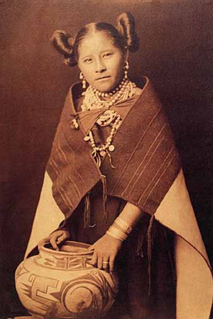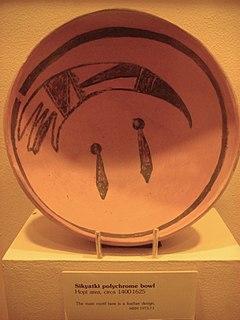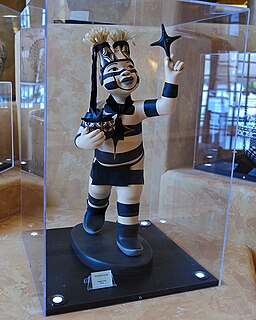
The Hopi are a Native American tribe who primarily live on the Hopi Reservation in northeastern Arizona. As of the 2010 census, there are 19,338 Hopi in the United States. The Hopi Tribe is a sovereign nation within the United States and has government-to-government relations with the United States federal government. Particular villages retain autonomy under the Hopi Constitution and Bylaws. The Hopi language is one of 30 in the Uto-Aztecan language family. The majority of Hopi people are enrolled in the Hopi Tribe of Arizona but some are enrolled in the Colorado River Indian Tribes. The Hopi Reservation covers a land area of 2,531.773 sq mi (6,557.26 km2).

The Hopi maintain a complex religious and mythological tradition stretching back over centuries. However, it is difficult to definitively state what all Hopis as a group believe. Like the oral traditions of many other societies, Hopi mythology is not always told consistently and each Hopi mesa, or even each village, may have its own version of a particular story, but "in essence the variants of the Hopi myth bear marked similarity to one another." It is also not clear that the stories told to non-Hopis, such as anthropologists and ethnographers, represent genuine Hopi beliefs or are merely stories told to the curious while keeping safe the more sacred Hopi teachings. As folklorist Harold Courlander states, "there is a Hopi reticence about discussing matters that could be considered ritual secrets or religion-oriented traditions."

A kachina is a spirit being in the religious beliefs of the Pueblo peoples, Native American cultures located in the south-western part of the United States. In the Pueblo cultures, kachina rites are practiced by the Hopi, Zuni, Hopi-Tewa, and certain Keresan tribes, as well as in most Pueblo tribes in New Mexico.

A kiva is a space used by Puebloans for rites and political meetings, many of them associated with the kachina belief system. Among the modern Hopi and most other Pueblo peoples, "kiva" means a large room that is circular and underground, and used for spiritual ceremonies.

Nampeyo (1859–1942) was a Hopi-Tewa potter who lived on the Hopi Reservation in Arizona. Her Tewa name was also spelled Num-pa-yu, meaning "snake that does not bite". Her name is also cited as "Nung-beh-yong," Tewa for Sand Snake.

Jesse Walter Fewkes was an American anthropologist, archaeologist, writer and naturalist.

Dan Namingha is a Hopi painter and sculptor. He is Dextra Quotskuyva's son, and a great-great-grandson of Nampeyo. He is a member of the Hopi-Tewa member of the Hopi Tribe. He lives in Santa Fe, New Mexico.

The Pueblo clowns are jesters or tricksters in the Kachina religion. It is a generic term, as there are a number of these figures in the ritual practice of the Pueblo people. Each has a unique role; belonging to separate Kivas and each has a name that differs from one mesa or pueblo to another.

Michael Kabotie, also known as Lomawywesa was a Hopi silversmith, painter, sculptor, and poet. He is known for his petroglyph and geometric imagery.

Hopi katsina figures, also known as kachina dolls, are figures carved, typically from cottonwood root, by Hopi people to instruct young girls and new brides about katsinas or katsinam, the immortal beings that bring rain, control other aspects of the natural world and society, and act as messengers between humans and the spirit world.

Fred Kabotie was a celebrated Hopi painter, silversmith, illustrator, potter, author, curator and educator. His native name in the Hopi language is Naqavoy'ma which translates to Day After Day.
Polacca is an unincorporated community in Navajo County, of northeastern Arizona, United States. It is Hopi-Tewa community on the Hopi Reservation.

Art of the American Southwest is the visual arts of the Southwestern United States. This region encompasses Arizona, New Mexico, and parts of California, Colorado, Nevada, Texas, and Utah. These arts include architecture, ceramics, drawing, filmmaking, painting, photography, sculpture, printmaking, and other media, ranging from the ancient past to the contemporary arts of the present day.

Dextra Quotskuyva Nampeyo is a Native American potter and artist. She is in the fifth generation of a distinguished ancestral line of Hopi potters.
Neil Randall David, Sr. Is a Hopi-Tewa American Indian artist and katsina carver. He learned the basics of carving from his grandfather Victor (Kawayo) Charlie.
Otellie Loloma was an American artist, specializing in Hopi traditional pottery and dance. Additionally she worked with her husband Charles Loloma on jewelry design.
Clara Lee Tanner was an American anthropologist, editor and art historian. She is known for studies of the arts and crafts of American Indians of the Southwest.

Priscilla Namingha Nampeyo was a Hopi-Tewa potter who was known for her traditional pottery. Namingha mined her own clay and created her own pigments for her large pots. Her work is in the collection of several museums and cultural centers.

Waldo Mootzka (1903–1940) was a Hopi watercolor artist.
















